Datasheet
Year, pagecount:2016, 7 page(s)
Language:English
Downloads:2
Uploaded:October 31, 2017
Size:830 KB
Institution:
-
Comments:
Attachment:-
Download in PDF:Please log in!
Comments
No comments yet. You can be the first!Most popular documents in this category
Content extract
Source: http://www.doksinet With competitive food industry for a competitive economy The Hungarian Government has recently drafted and adopted several industrial development strategies. The food industry has been identified as a priority area of development policy, being a major employer and a sector posting massive surpluses in foreign trade volume. This study overviews food industry value chains and the sector’s growth potential as cornerstones of a sector-specific development strategy. The emphasis of industry-focused international development policies have been shifted – thanks partly to Porter – from individual industrial sectors to value chains. Value chains operate as crossborder entities, as production and distribution networks form globalized markets In formulating Hungary’s industrial policy in general and creating a standpoint on measures aimed at the food industry in particular, it is certainly suitable to adopt this perspective. American economic literature uses
the word “agribusiness” as a comprehensive term for horizontal and vertical industrial ties related to agricultural production. The central element of the concept of “agribusiness” is agricultural production (raw materials and products gained through the cultivation of crops and animal husbandry) as well as the economic networks of manufacturing sub sectors. Nowadays, the competitiveness of agribusiness sectors is determined mainly by the concentration of capital, economies of scale and technological progress. It has to be noted that various sectors of the production chains of the food industry as well as vertical sectoral relations are tight-knit and functionally interdependent within the value chain. These have a mutual impact on one another, determining the quality and development level of the entire complex. This inter-dependence, multi-layered production chains and the sectors’ competitiveness accordingly require an integrated and holistic attitude also within
development policies. With a competitive agribusiness for a competitive economy The food industry has been one the flagships of Hungary’s industrial policy, due to its strategic and economic importance. Agribusiness has had a crucial impact on the competitiveness of the entire agricultural system. The food industry – as well as the sectors processing agricultural produce – creates a stable market and steady demand for the sector. The agricultural sector and the food industry have been traditional determinants in the economy of rural areas. In the EU’s developed economies, the food industry is a key factor in shaping the agricultural sector and Page: 1 / 7 Source: http://www.doksinet maintaining the level of employment in the countryside. Technological progress within the agricultural sector has gradually reduced labour demand but increased demand for the concentration of capital. During the knowledge-focused transformation of economy in the past 40 years, the food industry
has operated as a safety valve, which – being a labour-intensive sector -- has been capable of absorbing labour force that has become redundant in the agricultural sector. Although the sector has not provided the best wages, it was still capable of offering a sufficient number of moderate-paying jobs and thus retaining some labour force and population in rural areas. Higher concentration and technological intensity have been the two major outcomes of food industry development, and these have also led to the overhaul of traditional sub sectors. The agricultural sector provides agricultural produce that guarantee the competitiveness of the processing and food industries. As raw materials are transferable, the processing sectors may become capable of processing larger volumes of raw materials than those produced by regional agricultural producers. A good example for that are the German and Dutch food industries, capacities of which exceed the production capacities of the national
agricultural sectors. However, the existence of sectors providing the appropriate level of development of production inputs within the entire system is also important. The supporting and related sub sectors of the agricultural and processing sectors also include a number of other divisions such bio-technology, chemicals and machinery manufacturing, etc. Today’s typical agribusiness value-chains are characterized by globally controlled sectoral strategies and large corporations. The agricultural sector is capable of producing goods that are competitive and globally marketable, but processed goods are products of much higher added value which can be sold for a much larger profit. A World Bank study1 compares agricultural production and „entire” agribusiness systems. Agricultural output-to-GDP ratios show that even in developing countries the relative share of the agricultural sector tends to decrease parallel to the growth of per capita GDP. Also, parallel to the development of the
entire economic system, the performance and development of agriculture-related sub sectors, such as the food industry, processing industry and logistics, are gaining more and more weight. 1 World Bank (2008): Agriculture for Development. World Development Report 2008 World Bank, Washington DC. Page: 2 / 7 Source: http://www.doksinet Share of agribusinesses in GDP Source: World Bank (2008), pp. 155 As far as the foreign trade sector is concerned, agribusiness products may play a key role in both the imports and exports of a country, depending on favourable or adverse production conditions. The agricultural output of countries with good production parameters (area cultivated, technologies, business-oriented agricultural sector, skilled labour force, favourable R&D and innovation background), tend to a positive growth factor concerning the entire national economy. In Denmark, for example, agricultural output and the export of agricultural products account for some 23 percent of
the country’s GDP (Buday-Sántha, 2011). Demand for agricultural products shows a comparatively steady, slow growth trend, the share of which decreases parallel to the nominal expansion of global trade. In spite of the falling share, the volume and value of demand has been edging up. Taking a closer look at major agricultural trends clearly reveals that the relative weight of agricultural production and related employment as percentage of GDP has been falling within countries and globally as well. This trend is especially remarkable in developed countries (in Europe and the USA), where the sector’s relative economic weight in terms of output-to-GDP and employment does not exceed 2-3 percent and 3-4 percent, respectively. On the other hand, if we consider the ratio of the entire agribusiness sector to a country’s GDP, it is usually much higher. The volume of business turnover of the food industry is the largest in the world among the manufacturing sectors. Within the EU15, some 6
million people are employed by the sector (127 million within Page: 3 / 7 Source: http://www.doksinet the EU27), while some 20 million jobs are provided by the entire agribusiness system. In the US, the share of agricultural and agribusiness jobs is 2.5 percent and 157 percent of total, respectively. Naturally, the more highly developed the agribusiness system of a country is, the higher added value is produced and sold at global markets. The food industry as a potential driving engine of an agribusiness system The European (ECO) evaluates sectors in accordance with a three-star ranking system, based on size, specialization and the relative regional weight of the given activity. This ECO benchmark makes sectors of regions comparable within Europe. In the Southern Great Plain region, the agricultural and animal husbandry cluster has been awarded a three-star status, while in the category of agricultural products cluster, the region achieved a one-star status. The methodology of
Cluster Observatory is pointing to the formation of clusters in this sector and it can detect the existence of a potential leading cluster. Statistics on the number of industrial jobs aptly demonstrate the significance of the food industry, especially in the Great Plain region. Output data reveal that the food industry provides a significant share of total industrial output: some 2.8 percent within the national economy and 4 percent in the Great Plain region (2008). Share of industrial sectors in employment (2009) Source: KSH (2009): Regional statistical yearbook, 2009 Page: 4 / 7 Source: http://www.doksinet Share of industrial sectors in production (2009) Source: KSH (2009): Regional statistical yearbook, 2009 Food industry output accounted for 1.9 percent of total GDP in 2013, while the sector’s gross added value was 2.2 percent of that in the entire national economy This indicator had fallen from 2.7 percent in 2004, the year Hungary joined the EU, to below 2 percent by 2008,
and it has hovered around that level ever since. Page: 5 / 7 Source: http://www.doksinet Tendencies in the export of Hungarian food products Source: Ministry for National Economy (NGM), Eurostat (2015) The status of the Hungarian food industry has been determined by the fact that that the quality of avaialable agricultural raw materials is good, their quantity is sufficient, processing sector capacities are optimal and the labour force is relatively cheap. In the intensifying competition, the development of the food industry must focus on improving competitiveness, primarily through increasing the number of high added value products and engaging more and more foreign investors. Despite some negative trends prevalent in the agricultural sector and the food industry, the sector can be said to be successful on export markets, posting steady trade surpluses. And, although import growth has been exceeding export growth and terms of trade are deteriorating, the trade balance is still in
the green. As a typical trend, the nominal trade volume process goods – products with high added value – has increased, but in real terms there was no change in export composition. In addition to securing stable food supply, the sector’s strategic importance lies in employment potential. The food industry may be a key factor in retaining population in rural areas and stabilizing their quality of life in the medium term. This, however, requires the development of vocational education and vocational training systems. Having recognized the importance of the aforementioned factors, the Hungarian Government has increasingly turned the focus of sector-specific development policy on promoting investment, expanding capacities, boosting competitiveness and improving product quality in the sector. Page: 6 / 7 Source: http://www.doksinet Page: 7 / 7
the word “agribusiness” as a comprehensive term for horizontal and vertical industrial ties related to agricultural production. The central element of the concept of “agribusiness” is agricultural production (raw materials and products gained through the cultivation of crops and animal husbandry) as well as the economic networks of manufacturing sub sectors. Nowadays, the competitiveness of agribusiness sectors is determined mainly by the concentration of capital, economies of scale and technological progress. It has to be noted that various sectors of the production chains of the food industry as well as vertical sectoral relations are tight-knit and functionally interdependent within the value chain. These have a mutual impact on one another, determining the quality and development level of the entire complex. This inter-dependence, multi-layered production chains and the sectors’ competitiveness accordingly require an integrated and holistic attitude also within
development policies. With a competitive agribusiness for a competitive economy The food industry has been one the flagships of Hungary’s industrial policy, due to its strategic and economic importance. Agribusiness has had a crucial impact on the competitiveness of the entire agricultural system. The food industry – as well as the sectors processing agricultural produce – creates a stable market and steady demand for the sector. The agricultural sector and the food industry have been traditional determinants in the economy of rural areas. In the EU’s developed economies, the food industry is a key factor in shaping the agricultural sector and Page: 1 / 7 Source: http://www.doksinet maintaining the level of employment in the countryside. Technological progress within the agricultural sector has gradually reduced labour demand but increased demand for the concentration of capital. During the knowledge-focused transformation of economy in the past 40 years, the food industry
has operated as a safety valve, which – being a labour-intensive sector -- has been capable of absorbing labour force that has become redundant in the agricultural sector. Although the sector has not provided the best wages, it was still capable of offering a sufficient number of moderate-paying jobs and thus retaining some labour force and population in rural areas. Higher concentration and technological intensity have been the two major outcomes of food industry development, and these have also led to the overhaul of traditional sub sectors. The agricultural sector provides agricultural produce that guarantee the competitiveness of the processing and food industries. As raw materials are transferable, the processing sectors may become capable of processing larger volumes of raw materials than those produced by regional agricultural producers. A good example for that are the German and Dutch food industries, capacities of which exceed the production capacities of the national
agricultural sectors. However, the existence of sectors providing the appropriate level of development of production inputs within the entire system is also important. The supporting and related sub sectors of the agricultural and processing sectors also include a number of other divisions such bio-technology, chemicals and machinery manufacturing, etc. Today’s typical agribusiness value-chains are characterized by globally controlled sectoral strategies and large corporations. The agricultural sector is capable of producing goods that are competitive and globally marketable, but processed goods are products of much higher added value which can be sold for a much larger profit. A World Bank study1 compares agricultural production and „entire” agribusiness systems. Agricultural output-to-GDP ratios show that even in developing countries the relative share of the agricultural sector tends to decrease parallel to the growth of per capita GDP. Also, parallel to the development of the
entire economic system, the performance and development of agriculture-related sub sectors, such as the food industry, processing industry and logistics, are gaining more and more weight. 1 World Bank (2008): Agriculture for Development. World Development Report 2008 World Bank, Washington DC. Page: 2 / 7 Source: http://www.doksinet Share of agribusinesses in GDP Source: World Bank (2008), pp. 155 As far as the foreign trade sector is concerned, agribusiness products may play a key role in both the imports and exports of a country, depending on favourable or adverse production conditions. The agricultural output of countries with good production parameters (area cultivated, technologies, business-oriented agricultural sector, skilled labour force, favourable R&D and innovation background), tend to a positive growth factor concerning the entire national economy. In Denmark, for example, agricultural output and the export of agricultural products account for some 23 percent of
the country’s GDP (Buday-Sántha, 2011). Demand for agricultural products shows a comparatively steady, slow growth trend, the share of which decreases parallel to the nominal expansion of global trade. In spite of the falling share, the volume and value of demand has been edging up. Taking a closer look at major agricultural trends clearly reveals that the relative weight of agricultural production and related employment as percentage of GDP has been falling within countries and globally as well. This trend is especially remarkable in developed countries (in Europe and the USA), where the sector’s relative economic weight in terms of output-to-GDP and employment does not exceed 2-3 percent and 3-4 percent, respectively. On the other hand, if we consider the ratio of the entire agribusiness sector to a country’s GDP, it is usually much higher. The volume of business turnover of the food industry is the largest in the world among the manufacturing sectors. Within the EU15, some 6
million people are employed by the sector (127 million within Page: 3 / 7 Source: http://www.doksinet the EU27), while some 20 million jobs are provided by the entire agribusiness system. In the US, the share of agricultural and agribusiness jobs is 2.5 percent and 157 percent of total, respectively. Naturally, the more highly developed the agribusiness system of a country is, the higher added value is produced and sold at global markets. The food industry as a potential driving engine of an agribusiness system The European (ECO) evaluates sectors in accordance with a three-star ranking system, based on size, specialization and the relative regional weight of the given activity. This ECO benchmark makes sectors of regions comparable within Europe. In the Southern Great Plain region, the agricultural and animal husbandry cluster has been awarded a three-star status, while in the category of agricultural products cluster, the region achieved a one-star status. The methodology of
Cluster Observatory is pointing to the formation of clusters in this sector and it can detect the existence of a potential leading cluster. Statistics on the number of industrial jobs aptly demonstrate the significance of the food industry, especially in the Great Plain region. Output data reveal that the food industry provides a significant share of total industrial output: some 2.8 percent within the national economy and 4 percent in the Great Plain region (2008). Share of industrial sectors in employment (2009) Source: KSH (2009): Regional statistical yearbook, 2009 Page: 4 / 7 Source: http://www.doksinet Share of industrial sectors in production (2009) Source: KSH (2009): Regional statistical yearbook, 2009 Food industry output accounted for 1.9 percent of total GDP in 2013, while the sector’s gross added value was 2.2 percent of that in the entire national economy This indicator had fallen from 2.7 percent in 2004, the year Hungary joined the EU, to below 2 percent by 2008,
and it has hovered around that level ever since. Page: 5 / 7 Source: http://www.doksinet Tendencies in the export of Hungarian food products Source: Ministry for National Economy (NGM), Eurostat (2015) The status of the Hungarian food industry has been determined by the fact that that the quality of avaialable agricultural raw materials is good, their quantity is sufficient, processing sector capacities are optimal and the labour force is relatively cheap. In the intensifying competition, the development of the food industry must focus on improving competitiveness, primarily through increasing the number of high added value products and engaging more and more foreign investors. Despite some negative trends prevalent in the agricultural sector and the food industry, the sector can be said to be successful on export markets, posting steady trade surpluses. And, although import growth has been exceeding export growth and terms of trade are deteriorating, the trade balance is still in
the green. As a typical trend, the nominal trade volume process goods – products with high added value – has increased, but in real terms there was no change in export composition. In addition to securing stable food supply, the sector’s strategic importance lies in employment potential. The food industry may be a key factor in retaining population in rural areas and stabilizing their quality of life in the medium term. This, however, requires the development of vocational education and vocational training systems. Having recognized the importance of the aforementioned factors, the Hungarian Government has increasingly turned the focus of sector-specific development policy on promoting investment, expanding capacities, boosting competitiveness and improving product quality in the sector. Page: 6 / 7 Source: http://www.doksinet Page: 7 / 7
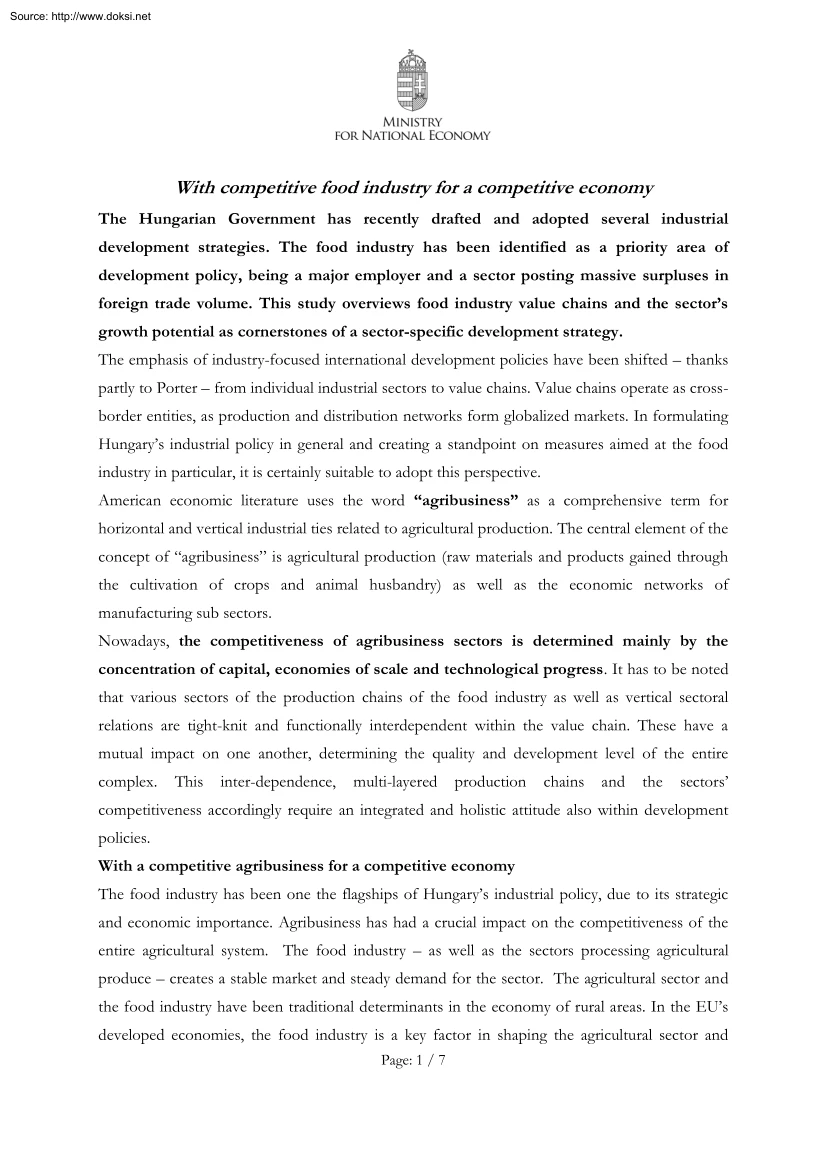
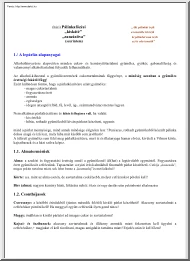
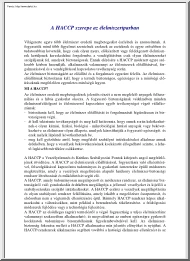
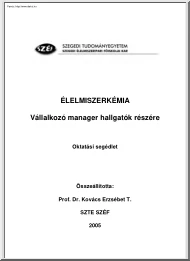
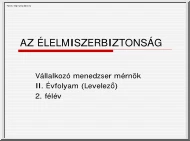
 Just like you draw up a plan when you’re going to war, building a house, or even going on vacation, you need to draw up a plan for your business. This tutorial will help you to clearly see where you are and make it possible to understand where you’re going.
Just like you draw up a plan when you’re going to war, building a house, or even going on vacation, you need to draw up a plan for your business. This tutorial will help you to clearly see where you are and make it possible to understand where you’re going.